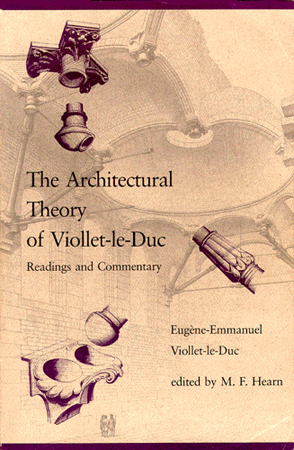

The Architectural Theory of Viollet-le-Duc: Readings and Commentary, 300 pp., 82 ill.; MIT Press, (Cambridge, Mass., 1990)
This compilation of readings, with commentary, from the numerous books of Eugène-Emmanual Viollet-le-Duc, the father of the theory of modern architecture, represents the first attempt by anyone to codify exactly what was the architectural theory of this conceptual giant. Following a biographical and bibliographical sketch, the readings begin by showing how Viollet-le-Duc's notions of architectural education and of the lessons to be drawn from historical architecture represent his own evolution as an aspiring architect, restorer, and theorist.
Viollet-le-Duc held that an architect should be educated in the engineering side of construction as well as the artistic and that a proper education would be gained from a balance of academic work and on-the-job training. Among the world's great architectural traditions, he admired those that he regarded as rational in their formulation. He held that the ancient Greek Doric temples represented the quintessence of rational structural composition, whereas the ancient Roman baths demonstrated the ingenious formulation of a variety of structural solutions by working from a program of functional requirements. The Gothic cathedrals of medieval France he held to be a synthesis of both ideals, marking the apex of sophistication in all architectural practice.
Planning, then, should be a rational process, beginning with a functional program and proceeding in logical steps from plan to structure and only then to elevation designs and décor. It was a method conceived as working from the inside out, in contrast to the earlier tradition of beginning with an ideal image and working from the outside in. The plan should evolve from a determination of the location of the building on the site, which would lead to placement of the primary space, followed in turn by its secondary and tertiary adjuncts in rational sequence. Only when the arrangement of spaces, systematically proportioned, was determined would it be appropriate to develop a structural scheme. The structural system should be apparent to a viewer and honestly represent the way it is composed. The use of materials should be equally straightforward and should be varied, so that each role in the construction is performed by the intrinsic properties of the material. Décor should be an inherent aspect of the design rather than an after-thought, and ideally it should emerge from the formulation of structure.
Viollet-le-Duc set out a number of hypothetical schemes to demonstrate ideas for a modern architecture. As he recognized, his own work was pedestrian in character, but his ideas inspired the entire international generation in continental Europe and the United States that produced the Art Nouveau—the first generation to produce a truly modern architecture. In the two succeeding generations these ideas were given varying degree of emphasis and new focus, but the theory of Viollet-le-Duc remained the generative inspiration for modern architecture until the last third of the twentieth century.
